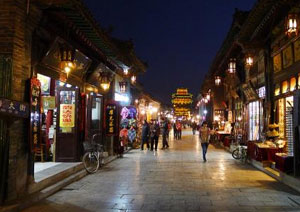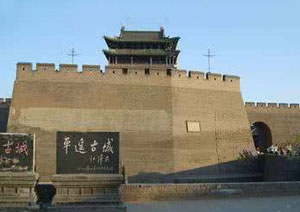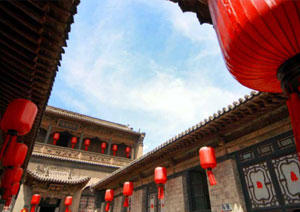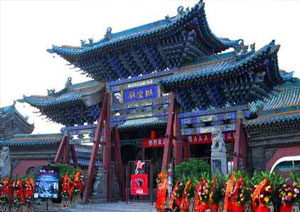
 Ming and Qing Street is the main commercial street in Ping Yao. It is also called "South Street" or "Nan Da Jie." It is said that it was the "Wall Street of China" in the past, and today it keeps the antique charm of the Ming and Qing Dynasties. This ancient street is 440 meters long, running from north to south down the center of the city, directly between the City government building and the Cheng Huang temple. A variety of businesses are located along the street. It is divided into the south street and the north street by the City Building. The styles of the shops are similar but not duplicates. The biggest antique market in Shanxi is located along the street.
Ming and Qing Street is the main commercial street in Ping Yao. It is also called "South Street" or "Nan Da Jie." It is said that it was the "Wall Street of China" in the past, and today it keeps the antique charm of the Ming and Qing Dynasties. This ancient street is 440 meters long, running from north to south down the center of the city, directly between the City government building and the Cheng Huang temple. A variety of businesses are located along the street. It is divided into the south street and the north street by the City Building. The styles of the shops are similar but not duplicates. The biggest antique market in Shanxi is located along the street.
 Pingyao is famous for its well-preserved ancient city wall in China. It was first built about 2,700 years ago; the ancient city wall was expanded in the Ming Dynasty. Finally, it stretches to the southern edge of the Taiyuan Basin and connects the Loess Plateau to the south. It can be regarded as an important communication bridge in old days along the Yellow River. The city wall consists of an unbroken rectangle and features a rammed-earth-and-brick structure that goes 6.2 kilometers around. It is 10 metres in length and 5 metres in width at the bottom and 2.5-6 metres on the top.
Pingyao is famous for its well-preserved ancient city wall in China. It was first built about 2,700 years ago; the ancient city wall was expanded in the Ming Dynasty. Finally, it stretches to the southern edge of the Taiyuan Basin and connects the Loess Plateau to the south. It can be regarded as an important communication bridge in old days along the Yellow River. The city wall consists of an unbroken rectangle and features a rammed-earth-and-brick structure that goes 6.2 kilometers around. It is 10 metres in length and 5 metres in width at the bottom and 2.5-6 metres on the top.
 The Qiao family Compound was built in 1756 during the Qing Dynasty (1644-1911). It is located sixty kilometers (37.3 miles) south of Taiyuan, the provincial capital of Shanxi, and about twenty kilometers (12.4 miles) north of Pingyao. The buildings have been well maintained despite the fact that the Qiao's family had lost their influence by the 1940's. The Compound was originally the home of the influential Qiao family. It was built by bean curd and tea merchant, Qiao Guifa, in the late 1700s and is well preserved. With their successful businesses, the Qiao family enjoyed a prestigious status in the Qing Dynasty during the reign of Emperor Qianlong (1735-1796). One of the members of the family traveled around the country and even to foreign countries, which made Qiao's business nationally influential.
The Qiao family Compound was built in 1756 during the Qing Dynasty (1644-1911). It is located sixty kilometers (37.3 miles) south of Taiyuan, the provincial capital of Shanxi, and about twenty kilometers (12.4 miles) north of Pingyao. The buildings have been well maintained despite the fact that the Qiao's family had lost their influence by the 1940's. The Compound was originally the home of the influential Qiao family. It was built by bean curd and tea merchant, Qiao Guifa, in the late 1700s and is well preserved. With their successful businesses, the Qiao family enjoyed a prestigious status in the Qing Dynasty during the reign of Emperor Qianlong (1735-1796). One of the members of the family traveled around the country and even to foreign countries, which made Qiao's business nationally influential.
 The Temple of the City God of Pingyao is in the east part of town. An ancient Taoist temple which boosts deeply religious, historical and cultural value, the temple was first built in the Northern Song Dynasty and was rebuilt several times during the Ming and Qing Dynasties. The present building dates back to the Qing Dynasty. It follows the Qing style of architecture. It has an elevation of 7,302 square meters with double eaves, cloisters, pavilions and glazed components. The temple is composed of four parts: the Liucaofu, Tuditang, Zaojun and Caishen temple, and is well preserved. The great gate, opera tower, halls, and bedrooms are arranged into four parallel courtyards. There is also a drum and bell tower near the entrance.
The Temple of the City God of Pingyao is in the east part of town. An ancient Taoist temple which boosts deeply religious, historical and cultural value, the temple was first built in the Northern Song Dynasty and was rebuilt several times during the Ming and Qing Dynasties. The present building dates back to the Qing Dynasty. It follows the Qing style of architecture. It has an elevation of 7,302 square meters with double eaves, cloisters, pavilions and glazed components. The temple is composed of four parts: the Liucaofu, Tuditang, Zaojun and Caishen temple, and is well preserved. The great gate, opera tower, halls, and bedrooms are arranged into four parallel courtyards. There is also a drum and bell tower near the entrance.
| Pingyao Attractions List | |

